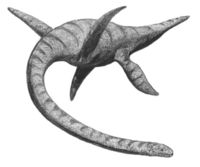|
Plesiosaurus |
||||||||||||||||
|---|---|---|---|---|---|---|---|---|---|---|---|---|---|---|---|---|
 |
||||||||||||||||
| Scientific classification | ||||||||||||||||
|
||||||||||||||||
|
P. dolichodirus P. guilelmiimperatoris ? P. brachypterygius (jr. synon.?) ? P. tournemirensis (jr. synon.?) |
Plesiosaurus (Greek: plesios, near to + sauros, lizard) was a large (about 3 to 5 meters long), marine Sauropterygian reptile that lived during the early part of the Jurassic period, and is known by nearly complete skeletons from the Lias of England and Germany. It was distinguished by its small head, long and slender neck, broad turtle like body, a short tail, and two pairs of large, elongated paddles. It lends its name to a larger group of reptiles as a whole Plesiosauria, of which it is an early but fairly typical member.
Contents |
Discovery
Plesiosaurus was one of the first of the "antediluvian reptiles" to be discovered (by Mary Anning), and excited great interest in Victorian England. It was so-named ("more lizard") by William Conybeare, to indicate that it was more like a normal reptile than Ichthyosaurus, which had been found in the same rock strata just a few years previously.
Description
The snout is short, but the mouth was able to open very wide, and the jaws are provided with a series of conical teeth in sockets, much like those of the living gavial. The neck is long and slender, but seems to have been rather stiff, because the vertebrae are nearly flat-ended, which indicates that it could not have been bent in the swan-fashion represented in many old restorations. The other vertebrae are similarly almost flat-ended and firmly united, and there is no sacrum. The ribs are single-headed, and in the middle of the trunk, between the supports of the paired limbs, they meet a dense plastron of abdominal ribs. The short tail is straight and rapidly tapering,
The pectoral and pelvic girdles which support the paired limbs are greatly expanded, the pectoral arch being similar to the corresponding bones of turtles.
The limbs are elongated paddles, with five complete digits, although each consists of a very large number of phalanges. Some traces of skin discovered suggest that it was smooth, not scaly.
Lifestyle
Plesiosaurus was exclusively marine, feeding on belemnites, fishes and other prey. It propelled itself by the paddles, the tail being too short to be of much use.
Species
At one time, Plesiosaurus was a wastebin taxon used to describe any Mesozoic plesiosaur of generally similar appearance. More recently there has been a number of revisions in sauropterygian taxonomy, and many species previously included here have been moved to other genera and families. Only two species are unambiguiously recognised.
Plesiosaurus dolichodeirus is the type species, known from the Lower Lias (Sinemurian) of Lyme Regis, which was about three metres long. Other plesiosauria from the same formation seem to have measured five to six metres in length.
Plesiosaurus guilelmiimperatoris is known from a large almost complete skeleton from the Upper Lias (Toarcian) of Württemberg. There seems to be the impression of a rhomboidal flap of skin in a vertical plane; if so, many plesiosaurs may have been equipped in this way.
Reference
- Richard Owen, Fossil Reptili of the Liassic Formations, pt iii. (Monogr. Palaeont. Soc., 1865)
External links
- Plesiosauroidea - Palaeos
- Plesiosauria – Mikko's Phylogeny Archive
This article incorporates text from the Encyclopædia Britannica Eleventh Edition, a publication now in the public domain.